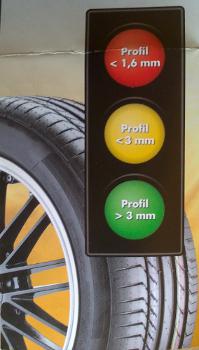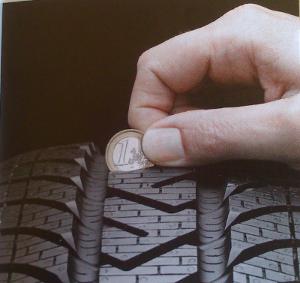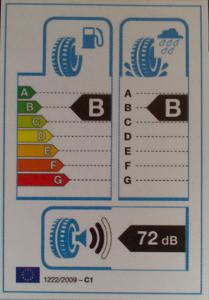Post by infinitycam07 on May 11, 2014 8:29:13 GMT -5
Hi there,
yesterday I have been at a tire repair service (some maybe know why) and there I found a quite interesting brochure of the German Road Safety Council (Deutscher Verkehrssicherheitsrat).
It's about what you have to pay attention to when you check your tires. There are many advices especially for Germans and (middle-)Europeans but some parts could also be interesting for the other participants of this forum. So I decided to translate it. So the following text is all from this brochure and also the pictures and this is all under the copyright of the German Road Safety Council.
With good tires safe through the summer!
Summer tires from O to O
Short explanation by me:
In Germany we have a rule of thumb, which you can't use in every country but in middle Europe it should work: It's called from O to O: "von Ostern bis Oktober" (from Easter to October).
This means you should use your summer tires from Easter to October and the winter tires from Ocotber to Easter. This rule works pretty good here.
"From Easter to October", this is the wording of the rule of thumb for the use of summer tires, which are the right choice at warm temperatures.
The rubber compound of the summer tires is designed especially for warm temperatures and dry as well as rain-wet roadways.
Thanks to reliable treads, summer tires stay driving stable also at hot asphalt. Wide tread grooves ensure a fast derivation of water and thus reduce the risk of aquaplaning.
Already checked tread depth?
The roadway is wet and the car gets into swimming? This is probably because of tires with too low tread depth. Tire experts recommend to drive summer tires only up to a tread depth of 3 millimetres, since the risk of aquaplaning increases otherwise:
The less profile a tire has, the less water it can displace. While a tire with 3 millimetres residual tread is at least able to hold roadway contact in the rain, a tire with 1.6 millimetres will swim. It's almost impossible for the driver to control the vehicle then.

"Profil" = "tread"
Tread depth check very simple
You can check the tread depth very fast with the help of an euro coin: disappears the golden border in the tread, the tread depth is sufficient, otherwise the tire should be replaced soon. Tires with less than 1.6 millimetres tread have to be replaced immediately, because this is the legal minimum tread depth (in Germany!). If the tread depth is below the punishments are a fine about 75 € and 3 points.

Tire check at a glance
Besides of a regularly check of the tread depth, the following properties of the tires should also be checked regularly:
Air pressure
Too low air pressure results in higher fuel consumption, decreasing driving stability, higher wear and a prolonged braking distance.
In the worst case the tires can burst.
Check the air pressure at every second refueling stop on a maximum lukewarm tire. The optimal air pressure should always correspond to the by the manufacturer recommended air pressure at full load (you can find it at the filler cap, door holm, glove box or in the instruction manual).
Age of tires
Check the tires, which are older than 6 years, more often, because they can get porous faster.
The DOT code at the tire indicates the date of manufacture:
DOT 2307 = production in calendar week 23, production year 2007.
Change latest after 10 years!
Tire damages
Punctures, cracks, dents and unbalances reduce the lifetime of the tires and can lead to bursting tires in the worst case.
Check your tires periodically towards such damages. While dents and big cracks are fast to see, small damages often stay invisible for the layman. Let the condition of the tires, especially before long trips, therefore check again from an expert. Also minimal unbalances, which can lead to a bursting tire in the worst case, will be discovered in time.
Last but not least some interesting information for EU citizens.
What is the EU tire label?

Since the 01.11.2012 applies for the trade in the whole EU a new requirement for the labelling of tires. Every tire, who is produced after the 30. June 2012, has to be marked with this EU tire label.
Safety first

The wet grip evaluates the grip of the tire and thereby of the whole car on a wet roadway. The better the assessment of the wet grip, the shorter is the braking distance on wet roadways.
With that increases the safety of driver, co-driver and all other traffic participants.

The rolling resistance is the power, which has to be mustered, to keep the tire on going. The higher the rolling resistance is, the more power must be expended to move forward. Or short: the higher the rolling resistance, the higher is the fuel consumption.
Between the single energy efficiency classes A to G is an additional average fuel consumption of respectively about one litre at 1000 kilometres route.

The noise emission provides information about the noise of the tire in decibel.
Since the tire label doesn't pay attention to many other factors, which evaluate the quality of a tire, like driving stability, lateral guidance in curves, resistance to aquaplaning, dry adhesion, and lifetime, the label can only limited contribute to a buying decision.
Play it safe and inform yourself before buying tires: advice from specialist retailers - tire tests in journals - web pages.
Tires are the only connection of the car to the street and an essential safety factor.
Better choose the tire with the shortest braking distance and save fuel by foresighted driving, regularly check of the air pressure and early upshift.

The picture shows the braking distance of a car with an output speed of 80 km/h (49.71 mph) on a wet street.
The basic braking distance with tires of the category A is around 45 m. From category to category the wet grip gets worse, so that the braking distance gets, in comparison to category A, about 18 m longer. The categories D and G are not occupied.
Text and pictures are under copyright of the German Road Safety Council (Deutscher Verkehrssicherheitsrat e.V.).
Well, I found that article rather interesting. Hope it will help you.
Best regards,
infinitycam07











